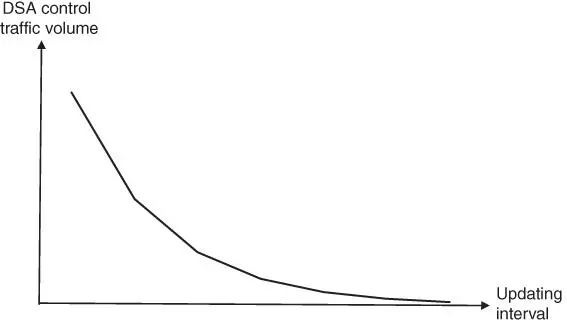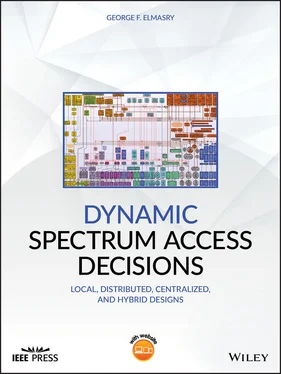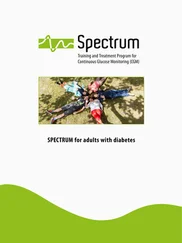3 If traffic levels go below the currently allocated levels, bandwidth over the offload datalinks will be reduced, releasing some of the spectrum resources. Corresponding message flow to the two cases above will ensure the release of resources is known to all involved engines.
4 If traffic levels go below a threshold, the flow over the offload data link will be torn down, releasing all resources back to the offload network.
Notice the following:
The low bandwidth global network is a lifeline to all nodes and is the start of the control plan. The control plane may use dynamic resource allocation (offload links) if needed.
All offload networks spectrum become shared spectrum resources pools for allocating spectrum resources per traffic demand.
The master routing engine is independent from the master DSA engine and the master routing engine has no say on how spectrum resources are to be allocated. This allows the inclusion of heterogeneous waveforms that use different resources allocation protocols within this heterogeneous hierarchical architecture. Each waveform can have a specific waveform DSA agent that works independently of other waveforms' DSA engines. One key aspect here is normalization of waveform metrics such that the master DSA agent uses unified resource allocation terms (e.g., flow) and the routing engines sees created routing paths in terms of unified data rate units (e.g., flow) and source destination pair. For the routing engines, a flow may be associated with a routing cost to allow the routing engine to ascertain the best route (path of multiple over‐the‐air hops).
The use of such dynamic link establishment, link adaptation, and link teardown means the use of a dynamic reactive routing protocol creating route tables that get modified quickly. When there is a steady‐state period, the cognitive engines will be monitoring the allocated flow's health and exchanging information. Information exchange during steady‐state periods can include spectrum health awareness and mobile node geolocations. The shared information will allow the waveform DSA and routing engines to anticipate the need for changes 10local to the network and react in a timely manner. Shared information will also allow the master DSA and routing engines to anticipate the need for global changes and react in a timely manner.
The master DSA engine is tightly coupled with the master routing engine in different ways. Consider the case when the master DSA engine is sharing spectrum awareness with its peer master DSA agents. The master DSA engine will rely on the dynamically created routes by the master routing engine and control traffic can become traffic demand on its own merit. If the global low‐bandwidth network cannot accommodate all control traffic volume, the offload network's spectrum resources would be used for control traffic.
The available resources on an established data link can change due to mobility, link stability, and link quality. For the cases where the waveform DSA engine learns new information about the link resources, the waveform DSA engine can inform the master DSA engine about any changes. One case of dynamically increasing link bandwidth due to mobility would be when a waveform switches to a lower forward error correction (FEC) mode, increasing throughput at close range while using the same amount of spectrum resources. 11On the other hand, a case of decreased bandwidth is when the waveform must switch to a higher FEC mode due to increased range or jamming. With dynamic MANET, situational awareness must be shared between all cognitive engines, which can result in constant change of routing tables, constant changes in spectrum resource allocation and teardown, and consequently increase in control traffic load. 12
Let us summarize the advantages of this heterogeneous distributed cooperative DSA approach:
Having a data plane that is independent of establishing offload links means the ability to exchange spectrum resources and link information before all networks are established.
Waveform engines can be developed independent of each other as long as the exchange of waveform information is normalized between all types of waveforms.
Waveforms can use their internal protocols for position awareness, antenna directionality, spectrum resources establishment, and teardown. Waveforms can decide how reactive routes local to the waveform network are established and torn down.
A large‐scale set of heterogeneous networks can be deployed together and these networks will morph to the unique scenario needs while the waveform cognitive engines manage the configuration of links internal to the waveforms network and the master engines manager global routes.
Making global dynamic route tables independent of route tables local to a network makes it possible for heterogeneous networks to be connected and optimized seamlessly.
There are also disadvantages of this heterogeneous distributed cooperative DSA approach:
The amount of DSA control traffic can grow exponentially as the number of nodes in a network increases and as the number of heterogeneous networks increases.
Some nodes can go out‐of‐synch or temporarily lose connectivity and some information exchange control traffic can be lost. Retransmission of control traffic can further cause an already large volume of DSA control traffic to grow larger and can delay the adaptive route creation decisions.
There are limits to global views of a large‐scale set of heterogeneous networks through distributed protocols. The master DSA agent in each gateway node will create a spectrum map that is less accurate than the spectrum map that can be created by a centralized arbitrator.
To make different types of IP networks work seamlessly, Internet routing protocols faced similar challenges to what is described here for DSA challenges. This led to the creation of routing areas and gateway protocols such as the border gateway protocol (BGP). In some IP network design, certain routing configurations had to be left for a centralized network manager to decide. Similarly, the reliance on a distributed cooperative DSA for large‐scale heterogeneous networks will always show some limitations and lead us to consider the need for a centralized spectrum arbitrator to curb control traffic volume and arbitrate fairly between heterogeneous networks in certain cases while allowing a human (network manager) to monitor the cognitive network's health and set policies and rule sets. The network manager can change policies when needed.
One simple way to curb control traffic volume is to reduce its rate. Figure 4.7illustrates a conceptual view of how control traffic volume can depend on the updating intervals. As updating interval periods decrease (more frequent exchange of DSA messages occur), control traffic volume increases. On the other hand, as the updating interval periods increase (less frequent exchange of messages occur), control traffic volume decreases. There is a desired cutoff limit of the amount of DSA control traffic depending on the heterogeneous systems under design. The limitation of the amount of DSA control traffic can lead to curbing message exchange rate and the impact of this limitation can make resource allocation and dynamic routing tables less dynamic and less reactive to the deployment needs. This can be harmful, especially for fast‐moving nodes in very dynamic MANETs.

Figure 4.7Conceptual view of how control traffic volume depends on updating rate.
Notice that within the heterogeneous MANET designs presented in this section, the distributed cooperative DSA 13has a mix of local DSA decisions made by the waveform DSA engine and distributed DSA decisions made between the master DSA agents. Although these systems are referred to as distributed cooperative DSA systems, in essence they are hybrid between local DSA and distributed DSA decision systems with two different hierarchies of distributed cooperative decision fusion. Similarly, adding a centralized arbitrator to this construct creates a different type of hybrid DSA design that has more hierarchical DSA entities.
Читать дальше













